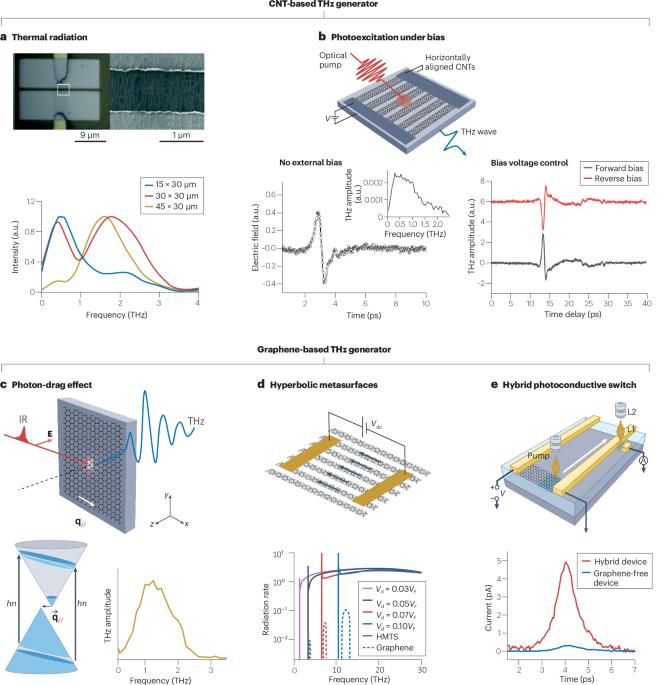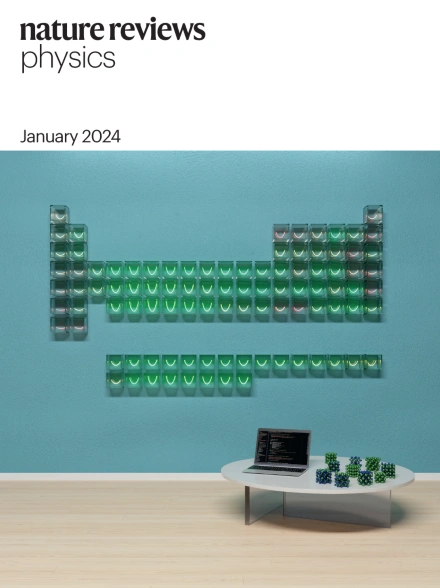Carbon-nanomaterial-enabled terahertz technology
IF 39.5
1区 物理与天体物理
Q1 PHYSICS, APPLIED
引用次数: 0
Abstract
Terahertz (THz) technology bridges the gap between electronics and photonics, unlocking transformative opportunities in medical diagnostics, molecular identification and next-generation wireless networks. Usually, THz devices have been made from conventional semiconductors and their heterostructures to achieve the necessary carrier transport properties and optical-to-THz conversion efficiencies. In the past decade, carbon nanomaterials, such as carbon nanotubes and graphene, have been successfully used in the development of THz devices, including emitters, detectors and modulators. These advances are enabled by the unique properties of these materials, including strong linear and nonlinear THz radiation absorption, ultrahigh carrier mobilities and facile gate tunability. In this Review, we present the latest advances in the generation, detection and modulation of THz radiation using carbon nanomaterials, particularly focusing on the use of carbon nanotubes and graphene. The challenges and opportunities of using carbon nanomaterials in THz technology and towards potential applications are discussed. Carbon nanomaterials have strong electron–photon interactions in the terahertz range, gate-tunable photoresponse and high carrier mobilities. This Review provides a discussion of the use of carbon nanotubes and graphene for the generation, detection and modulation of terahertz waves.

碳纳米材料驱动的太赫兹技术
太赫兹(THz)技术弥合了电子学和光子学之间的差距,为医疗诊断、分子识别和下一代无线网络带来了变革性机会。通常,太赫兹器件由传统半导体及其异质结构制成,以实现必要的载流子输运特性和光到太赫兹的转换效率。在过去的十年里,碳纳米材料,如碳纳米管和石墨烯,已经成功地应用于太赫兹器件的开发,包括发射器、探测器和调制器。这些进步是由这些材料的独特特性实现的,包括强线性和非线性太赫兹辐射吸收,超高载流子迁移率和易于栅极可调性。在这篇综述中,我们介绍了碳纳米材料在太赫兹辐射的产生、检测和调制方面的最新进展,特别是碳纳米管和石墨烯的使用。讨论了在太赫兹技术中使用碳纳米材料的挑战和机遇以及潜在的应用前景。碳纳米材料在太赫兹范围内具有强的电子-光子相互作用,门可调谐光响应和高载流子迁移率。本文综述了碳纳米管和石墨烯在太赫兹波的产生、探测和调制中的应用。
本文章由计算机程序翻译,如有差异,请以英文原文为准。
求助全文
约1分钟内获得全文
求助全文
来源期刊

Nature Reviews Physics
Multiple-
CiteScore
47.80
自引率
0.50%
发文量
122
期刊介绍:
Nature Reviews Physics is an online-only reviews journal, part of the Nature Reviews portfolio of journals. It publishes high-quality technical reference, review, and commentary articles in all areas of fundamental and applied physics. The journal offers a range of content types, including Reviews, Perspectives, Roadmaps, Technical Reviews, Expert Recommendations, Comments, Editorials, Research Highlights, Features, and News & Views, which cover significant advances in the field and topical issues. Nature Reviews Physics is published monthly from January 2019 and does not have external, academic editors. Instead, all editorial decisions are made by a dedicated team of full-time professional editors.
 求助内容:
求助内容: 应助结果提醒方式:
应助结果提醒方式:


